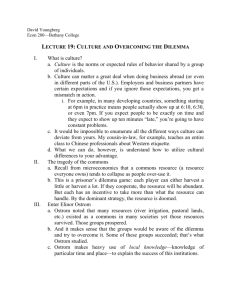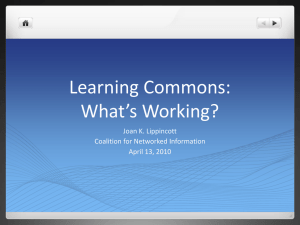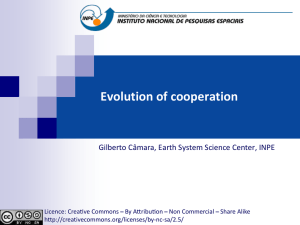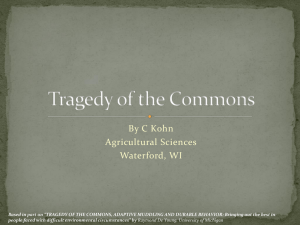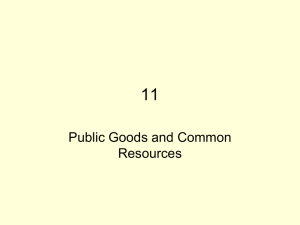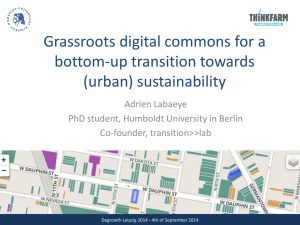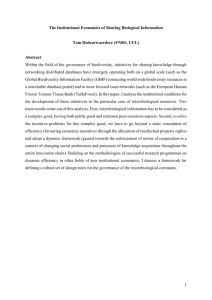Lecture on Elinor Ostrom and Tragedy of the
advertisement
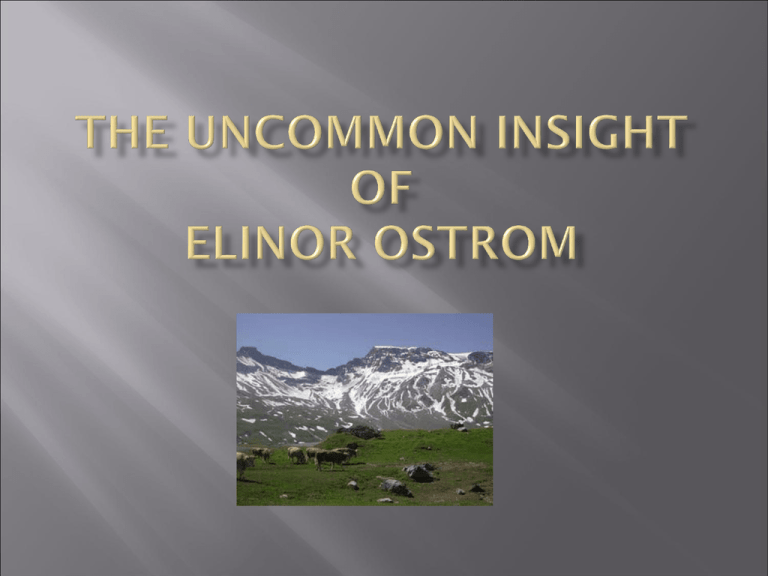
“Picture a pasture that is open to all. Each herdsman will try to keep as many cattle as possible on the commons…the inherent logic of the commons remorselessly generates tragedy.” ---Garrett Hardin, The Tragedy of the Commons 1968 A key characteristic of “local” commons is that there are typically several participants (but a relatively small “several”.) Hardin applied the commons metaphor to “global” commons problems such as largescale air and water pollution and overpopulation. Ostrom has concentrated her attention on local commons. Pastures Woodlands Fishing grounds Hunting Grounds Watersheds Ground Water Basins Oil Fields Parking spaces Instinctive economists’ approach: Model common commons problem as an “appropriation game”. Common resource shared by N players, intensity of use by i is xi. number of cows pastured, amount of water extracted, etc Payoff to player i is Pi(xi,Σxj). Given actions of others, Pi(xi,Σxj) is increasing in xi over some range and then decreasing. Pi xi Pi(xi,Σxj) is a decreasing function of Σx Under plausible assumptions, this game will have a unique Nash equilibrium. In Nash equilibrium each user imposes a “negative externality” on all other users, but does not take this into account when choosing his intensity of use. This equilibrium will not be Pareto efficient. The resource will be overused. Centrally enforced solutions: “Pigovian solution”: Price the externality. Find the optimal solution, charge an access fee equal to the total externality caused by an extra use. Legal limits on quantities extracted by each individual “Enclosure” Privatize the commons by assigning property rights to exclusive use Centrally imposed solutions require central knowledge of payoff functions and public observability of activities of each individual. They require a non-corrupt central authority. They require intelligent political decision-making by central authority. Requires enforcement of property rights and monitoring of action of users. Fencing the range land. Patrolling the berry patches. How does one assign property rights to flowing water, swimming fish, or game in the forest? Transferring property rights to a single owner introduces the holdout problem. Similar to land assembly problems Ostrom proposed that we learn from case studies of successful and unsuccessful real world common property institutions. She conducted field studies and studied the field studies of others. She found that enduring institutions achieved more efficient outcomes than Nash equilibrium for simple game, but were not the predicted first-best efficient outcomes. Mountain meadow and forests in Swiss Alps and in mountains of Japan. Irrigation systems in Spain, the Philippines, Sri Lanka, and Nepal Fisheries in Turkey, Sri Lanka, and Nova Scotia Ostrom documents overexploitation and rent dissipation Fisheries in Turkey, Sri Lanka Water basins in the U.S Enclosure often replaces commons. Ostrom noted that many commons problems are not one-shot games, but repeated games, played year after year. The Swiss canton of Törbel has maintained communal management of forests and meadows for more than 500 years. Irrigation institutions in Spain are also more than 500 years old. What does game theory predict for repeated games? Folk theorem: In a repeated game without a fixed end point, if players are well-informed about each others actions, almost any behavior can be sustained as a Nash equilibrium (by strategies that punish deviations.) Some of these equilibria will be efficient. Some will not be. Neither Nash equilibrium of one-shot game, nor Pareto optimal outcome is a reliable predictor of outcome. Ostrom suggests a fruitful path. Outcomes are not well predicted by simple models that incorporate few facts. Study a large number of durable and less durable institutions. Look for regularities. Try to understand what happens and why. This requires detailed observation, guided by sophisticated theory. Clear boundaries of resource and of the group who share it. Congruence of benefit shares and cost shares. Constitutional rules for changing operating rules. Monitoring. Graduated sanctions. Conflict resolution mechanism. Finding and enforcing a nearly efficient allocation is relatively easy in a symmetric game where it is efficient for everyone to be treated equally. More challenging where there are important differences in the interests and bargaining positions of players. Landholders near headwaters have advantage over those downstream. Some land is more suitable for waterintensive crops. Elaborate rules for allocating water under different scarcity conditons. Philippines-symmetrization by allocating some land near head and some near bottom to each landholder. Durable institutions must be internally stable. They need not be efficient. Ostrom’s case studies document this. Group selection may impose some efficiency. Analogy to medicine. Observe what has evolved, try to understand how it works. Where outcome is inefficient, seek alternative designs that are internally consistent and likely to work. Mechanism designers need to observe and understand existing institutions before tinkering. Example: Medical intern matching algorithm. Successful commons operations are enforced by norms. Norms are monitored by entire population. Humans seem to have an evolved ability to generate and follow norms. Like potential for language, can take many forms Experimental evidence. Where does altruism enter? Helps when information is incomplete Limits variety of solutions in repeated games. Kin selection theory and the family as a commons. Agriculture displaces hunter gathering. Fixed, appropriable resources. Cheaper fencing makes enclosure of pastures possible. Manufacturing allows clear ownership rights. But the information economy is a commons. An idea is no easier to appropriate than wild game or running water. Information economy has been described as an “anti-commons”. Instead of a game in which substitute goods are depleted, complement goods are added by individual contributors. Nash equilibrium has undersupply. Privatizing ideas with patents does not help. Success Stories The internet Open access publishing Open source software Patent pools Google Wikipedia Tales of Woe Patent morasses Monopolies Nobel ceremonies, a week of celebration of science. Work of Ostrom dramatizes the potential of social science as a multidisciplinary, multi-method commons. Theory, case studies, experiments Political Science, Economics, Game theory, History, Anthropology, Ecology Antidote for inbreeding--Hybridization
